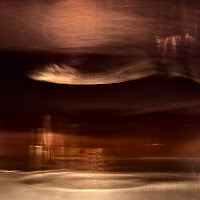...to which the tagline can read: a snapshot of the corner shelf in the study of a photographer prone to a gentle madness (where the "madness" refers to the deep passion for books, and is part of the title of a book - not shown - that describes that passion). My home, much to wife's dismay, is filled with books; all kinds of books; a veritable (countable) infinity of books, though a demonstrably smaller infinity than, say, the infinity represented by the categories one can imagine by which these books can all be distinguished, and that they collectively represent an intertwined wisdom about. Short books, and long; dime-store paperbacks and coffee-table-sized hardcovers; textured papers and glossy; those with pictures and others with only text; books about history and culture; philosophy, art, religion and Zen; the collected works of Chekov, Ellery Queen, Stanislaw Lem, and Philip K. Dick (with scattered books and tapes by Alan Watts); travelogues about conquests of Everest, Antarctica, and Ayahuasca; biographies of Maxwell, Dirac, and Feynman, as well as Ansel, Cartier-Bresson, and two Westons (Edward and Brett); books on self-organized vortices of consciousness and anything else mused on by Hofstadter; Christopher Alexander's magnum opus; and more books on physics and photography than most dreams can conjure over a dozen or more nights!
Borges famously introduced a ridiculously wondrous taxonomy of all knowledge in his 1942 essay "The Analytical Language of John Wilkins" (which he claims to have taken from an ancient Chinese encyclopedia, Celestial Emporium of Benevolent Knowledge). The categories of animals alone includes:
"Those that belong to the emperor;
Embalmed ones;
Those that are trained;
Suckling pigs;
Mermaids (or Sirens);
Fabulous ones;
Stray dogs;
Those that are included in this classification;
Those that tremble as if they were mad;
Innumerable ones;
Those drawn with a very fine camel hair brush;
Et cetera;
Those that have just broken the flower vase;
Those that, at a distance, resemble flies."
And to this whimsical classification I introduce another that leads directly to the title of this blog: an image of the books (and of whatever else might fall onto your camera's sensor) that sits directly in front of you as you work on your images on a computer. Arbitrary? To be sure. Meaningful? Only to the extent that it is a well-formed query that has a definite answer; it may even provide a glimpse of what "interests one" most, right now, as in "I need this and that reference to be by my side." If we are what we read (and eat, and see, and do, ...) then surely our most immediate literary/visual companions are what we are at this moment (so long as they assembled on the shelf by themselves).
So my soul, right now, evidently needs these 15 books to be within easy reach as I muse and ponder and tinker with tones and forms on my computer: 9 are related to photography, 3 to art, and 1 each to mathematics, physics, and an "uncategorizable" category onto itself (best defined by its title: The Art of Looking Sideways); well, these books and an image of an old, wise sea turtle who - like a Zen sage - quietly reminds me of the transience of all categories and classifications, and that, eventually, even my desire to look sideways will drift into a timeless void.
What do you, kind reader, find on your easy-to-reach shelf of books and memorabilia?
So my soul, right now, evidently needs these 15 books to be within easy reach as I muse and ponder and tinker with tones and forms on my computer: 9 are related to photography, 3 to art, and 1 each to mathematics, physics, and an "uncategorizable" category onto itself (best defined by its title: The Art of Looking Sideways); well, these books and an image of an old, wise sea turtle who - like a Zen sage - quietly reminds me of the transience of all categories and classifications, and that, eventually, even my desire to look sideways will drift into a timeless void.
What do you, kind reader, find on your easy-to-reach shelf of books and memorabilia?


































